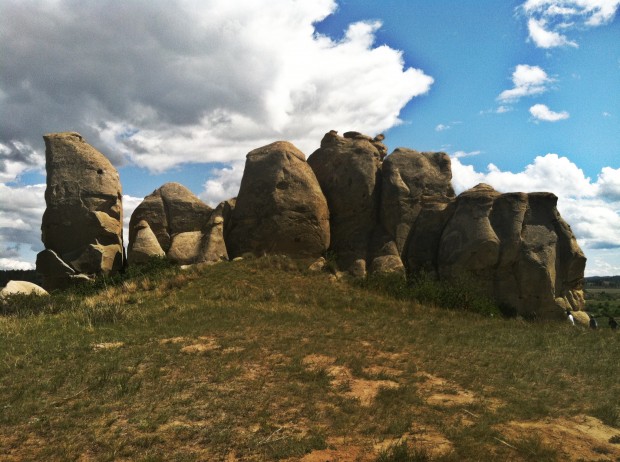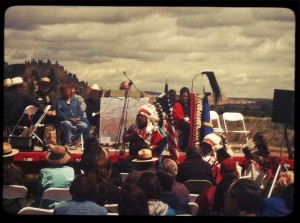We have much more to do and your continued support is needed now more than ever.
Protecting the cultural and historic values of the Powder River Basin

Yesterday, in the beautiful Rosebud valley in southeastern Montana, hundreds gathered to celebrate and honor an important and sacred place, Deer Medicine Rocks, as a National Historic Landmark. Northern Cheyenne, Oglala Lakota, ranchers, historians, and others came to this remote site, just north of the Northern Cheyenne Reservation to honor and recognize a place where Native Americans have carved their prophecies, their history and their dreams for thousands of years. I was honored to attend the celebration as a representative of NWF’s Tribal Lands Partnerships Program and as a proud Montanan. Deer Medicine Rocks demands your attention. It juts out into the never ending Montana sky amid other sandstone bluffs and prairie and sage brush flats. This region and the abundant wildlife that call it home, is one of the most special in all of Montana and the Nation. When you step foot in this country, you’ll never forget it.
Petroglyphs cover the walls of the sandstone face of the rocks, including a rock art inscription of the prophecy of a tribal victory at the Battle of the Little Bighorn that was revealed Hunkpapa Lakota medicine man Sitting Bull during a Sun Dance held in the Rosebud Valley in June 1876. For those of you who may never make it out to southeastern Montana to see this amazing place, the National Park Service has described some of the petroglyphs that reveal themselves on the rocks.
 “There are elk with tracks; buffalo bull sitting down (possibly Sitting Bull’s signature); buffalo tracks; bear tracks and a grizzly bear; mountain sheep; deer; birds; salamanders; a thunderbird; a coyote; the sacred Sun Dance of the Lakota people, with pole and piercing of the flesh; tepees; a man on horseback; war regalia in the form of bear claws, a mirror, and eagle bone whistles; a view of soldiers with grasshopper-like legs falling into camp; a medicine wheel with quadrants including a moon and a man smoking a pipe; and a human with a shield.
“There are elk with tracks; buffalo bull sitting down (possibly Sitting Bull’s signature); buffalo tracks; bear tracks and a grizzly bear; mountain sheep; deer; birds; salamanders; a thunderbird; a coyote; the sacred Sun Dance of the Lakota people, with pole and piercing of the flesh; tepees; a man on horseback; war regalia in the form of bear claws, a mirror, and eagle bone whistles; a view of soldiers with grasshopper-like legs falling into camp; a medicine wheel with quadrants including a moon and a man smoking a pipe; and a human with a shield.

On the northeast side, a lightning bolt struck the rock creating a blue stripe that seared through the image of a deer and knocked away a piece of the stone thereby providing the site’s most common name, “Deer Medicine Rocks.” National Park Service
Deer Medicine Rocks is one of the cultural treasures of the Powder River Basin that now has national recognition, along with the Rosebud Battlefield, as an important site that needs to be protected for future generations. However, many other historical and cultural sites like this are under threat from increased coal leasing and development in the Powder River Basin. Yesterday, as I listened to Cheyenne and Oglala cultural leaders talk about the importance of the Rocks, I was reminded of a poem entitled “Things of Intrinsic Worth” written by my friend Wally McRae. If you have a moment, watch Wally read his poem and think about this important place and the people and wildlife that call it home. It is now in the cross hairs for massive industrialization. This region need not be a National Sacrifice Area. For more photos of the event, please visit our Tribal Lands facebook page, www.facebook.com/triballands. To learn more about NWF’s Tribal Lands Partnerships Program, please go to: http://www.nwf.org/Wildlife/What-We-Do/Tribal-Lands.aspx
[vimeo]http://vimeo.com/26692651[/vimeo]





















